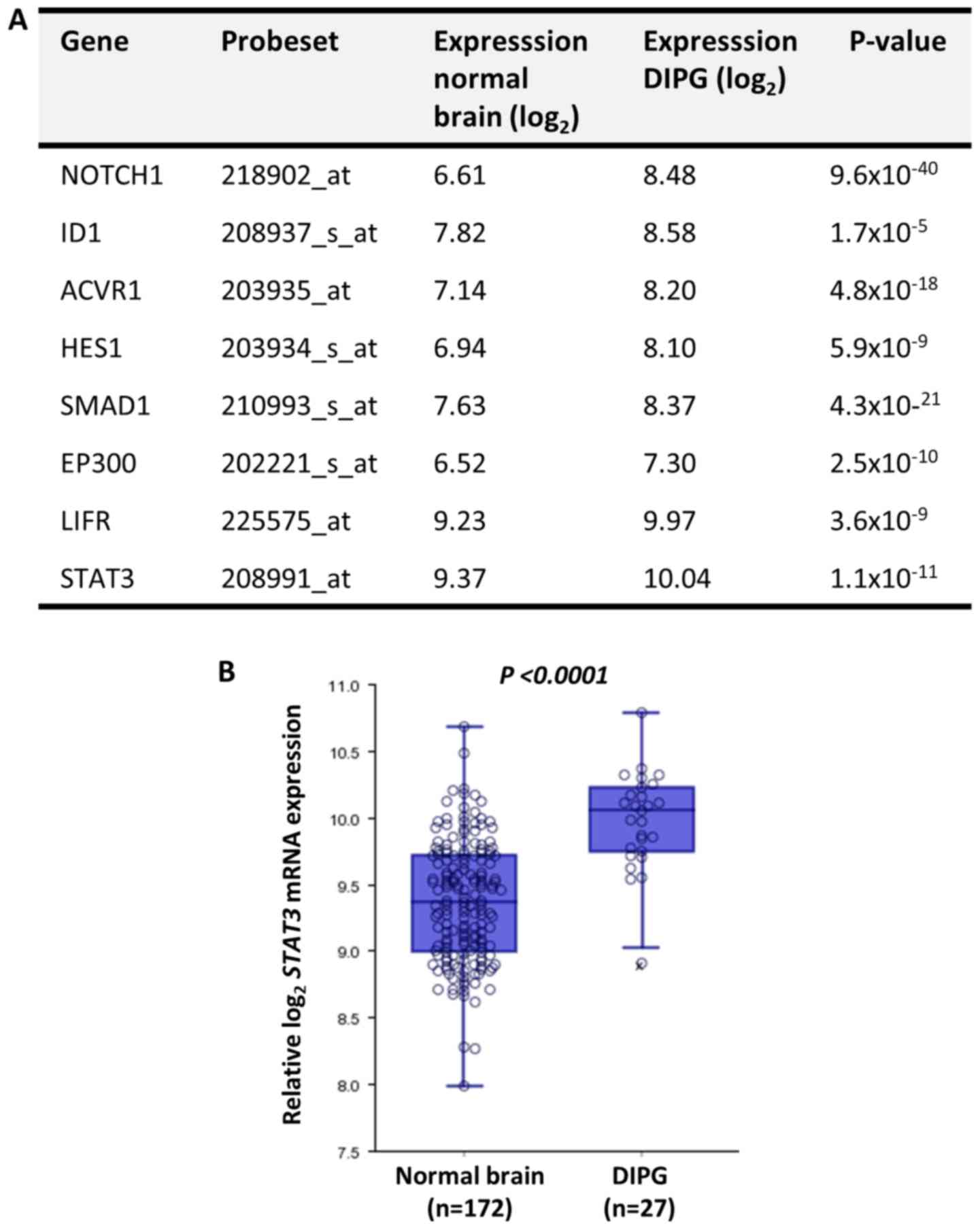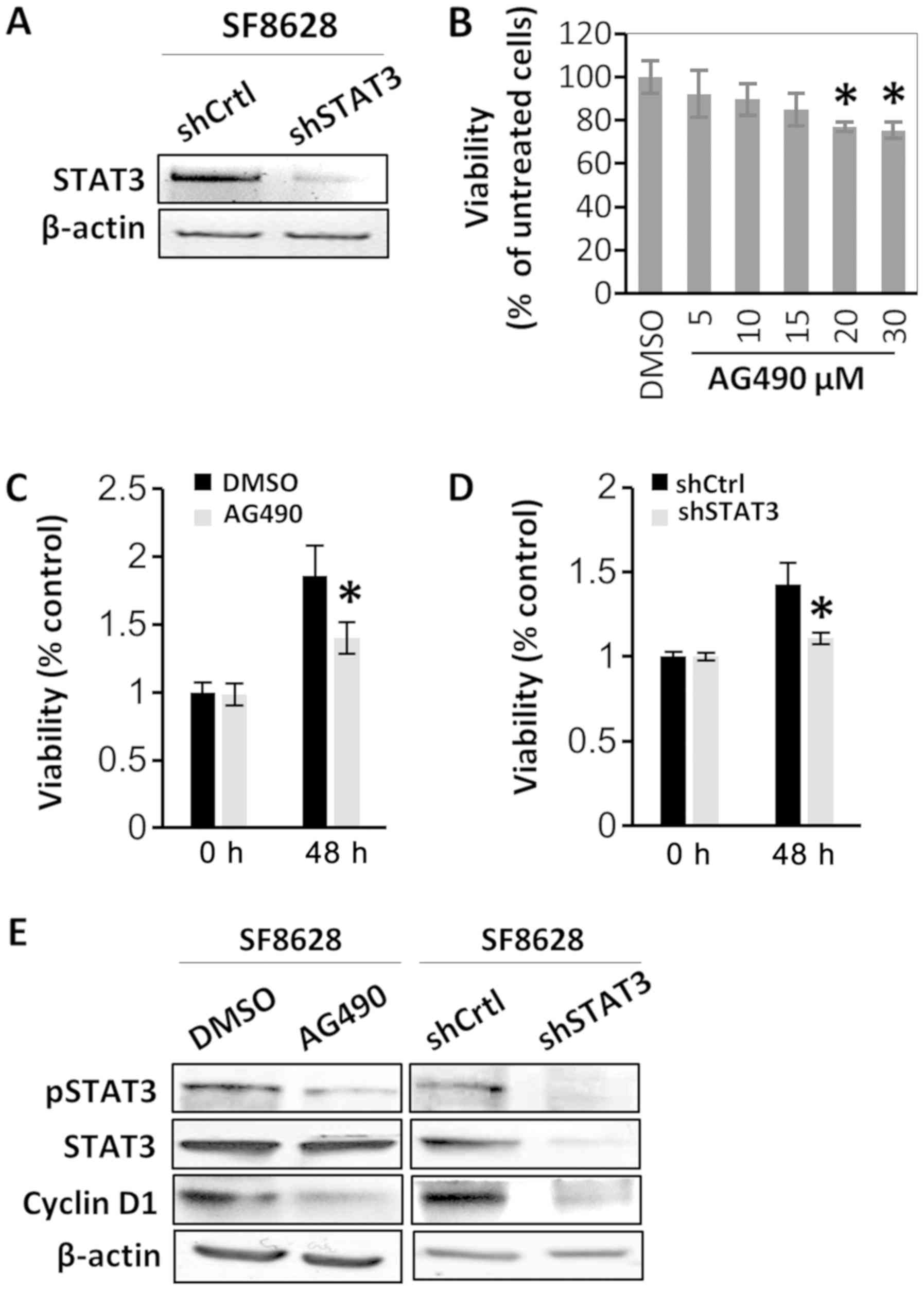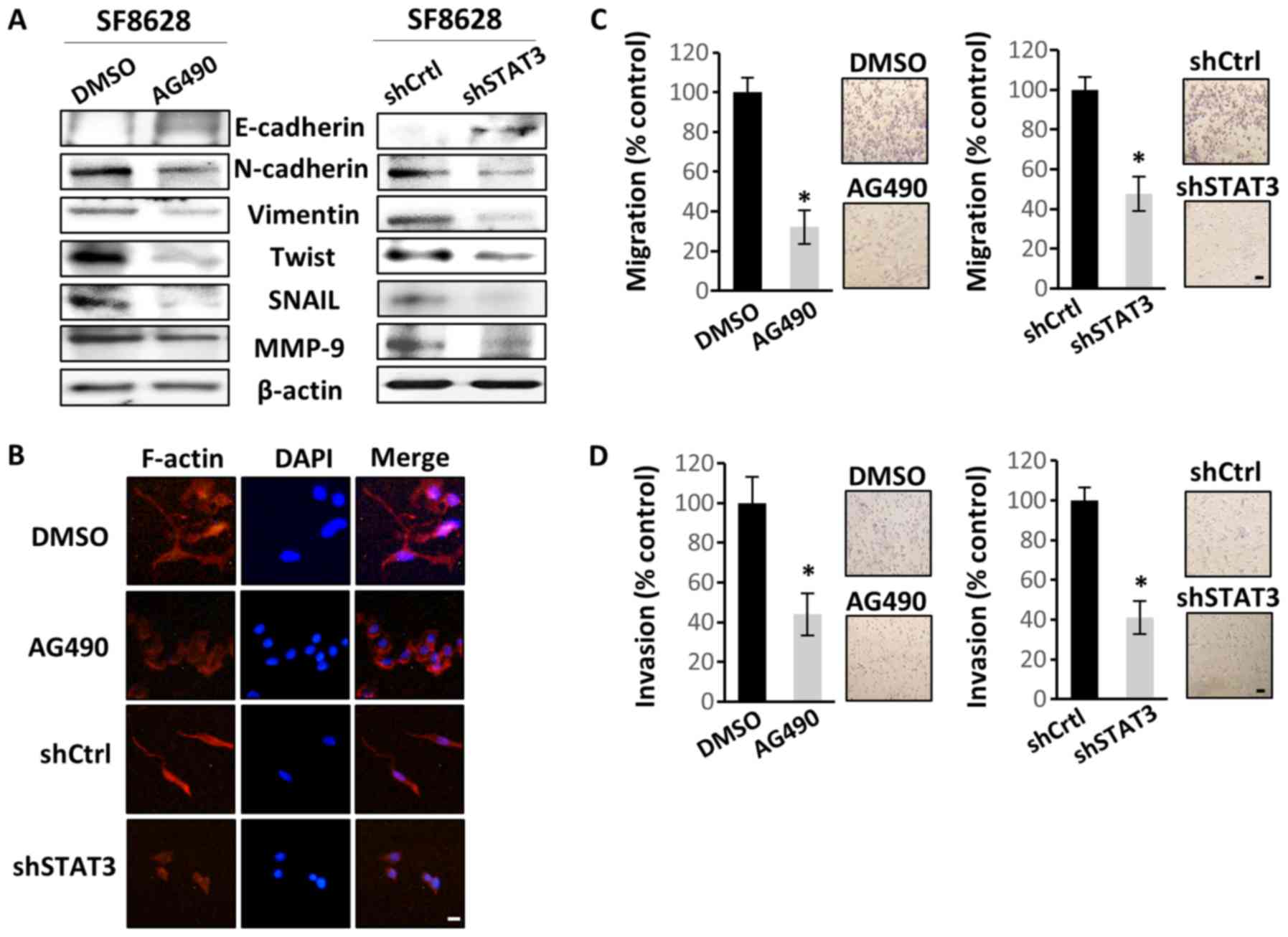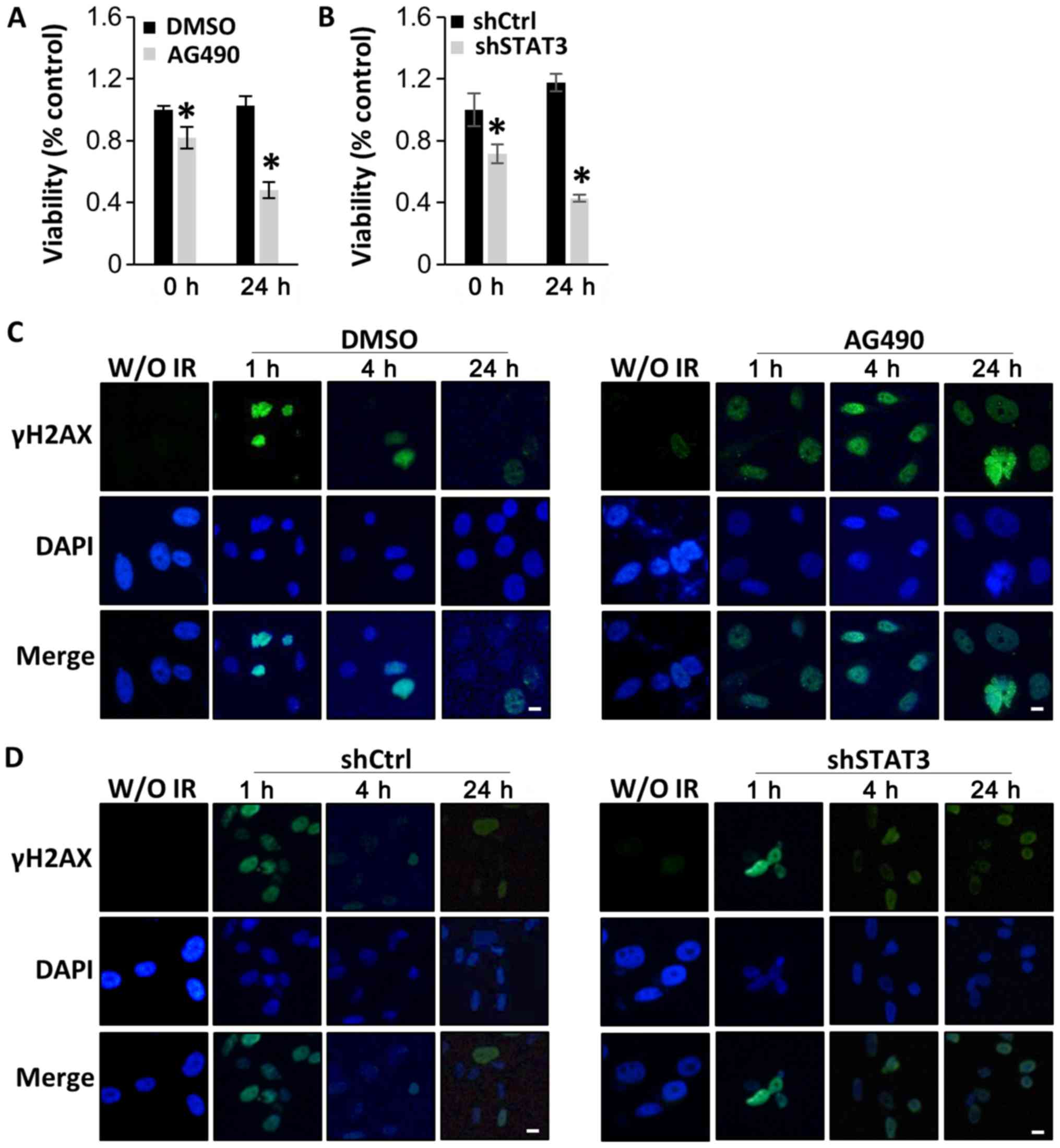|
1
|
Warren KE: Diffuse intrinsic pontine
glioma: Poised for progress. Front Oncol. 2:2052012. View Article : Google Scholar : PubMed/NCBI
|
|
2
|
Khatua S, Sadighi ZS, Pearlman ML, Bochare
S and Vats TS: Brain tumors in children-current therapies and newer
directions. Indian J Pediatr. 79:922–927. 2012. View Article : Google Scholar : PubMed/NCBI
|
|
3
|
Vanan MI and Eisenstat DD: DIPG in
Children-what can we learn from the past? Front Oncol. 5:2372015.
View Article : Google Scholar : PubMed/NCBI
|
|
4
|
Jansen MH, Van Vuurden DG, Vandertop WP
and Kaspers GJ: Diffuse intrinsic pontine gliomas: A systematic
update on clinical trials and biology. Cancer Treat Rev. 38:27–35.
2012. View Article : Google Scholar : PubMed/NCBI
|
|
5
|
Pollack IF, Jakacki RI, Blaney SM, Hancock
ML, Kieran MW, Phillips P, Kun LE, Friedman H, Packer R, Banerjee
A, et al: Phase I trial of imatinib in children with newly
diagnosed brainstem and recurrent malignant gliomas: A pediatric
brain tumor consortium report. Neuro Oncol. 9:145–160. 2007.
View Article : Google Scholar : PubMed/NCBI
|
|
6
|
Geoerger B, Hargrave D, Thomas F, Ndiaye
A, Frappaz D, Andreiuolo F, Varlet P, Aerts I, Riccardi R, Jaspan
T, et al: Innovative therapies for Children with cancer pediatric
phase I study of erlotinib in brainstem glioma and
relapsing/refractory brain tumors. Neuro Oncol. 13:109–118. 2011.
View Article : Google Scholar : PubMed/NCBI
|
|
7
|
Wu G, Diaz AK, Paugh BS, Rankin SL, Ju B,
Li Y, Zhu X, Qu C, Chen X, Zhang J, et al: The genomic landscape of
diffuse intrinsic pontine glioma and pediatric non-brainstem
high-grade glioma. Nat Genet. 46:444–450. 2014. View Article : Google Scholar : PubMed/NCBI
|
|
8
|
Hall A, Giese NA and Richardson WD: Spinal
cord oligodendrocytes develop from ventrally derived progenitor
cells that express PDGF alpha-receptors. Development.
122:4085–4094. 1996.PubMed/NCBI
|
|
9
|
Verschueren K, Dewulf N, Goumans MJ,
Lonnoy O, Feijen A, Grimsby S, Vandi Spiegle K, ten Dijke P, Morén
A, Vanscheeuwijck P, et al: Expression of type I and type IB
receptors for activin in midgestation mouse embryos suggests
distinct functions in organogenesis. Mech Dev. 52:109–123. 1995.
View Article : Google Scholar : PubMed/NCBI
|
|
10
|
Buczkowicz P, Bartels U, Bouffet E, Becher
O and Hawkins C: Histopathological spectrum of paediatric diffuse
intrinsic pontine glioma: Diagnostic and therapeutic implications.
Acta Neuropathol. 128:573–581. 2014. View Article : Google Scholar : PubMed/NCBI
|
|
11
|
Saratsis AM, Kambhampati M, Snyder K,
Yadavilli S, Devaney JM, Harmon B, Hall J, Raabe EH, An P, Weingart
M, et al: Comparative multidimensional molecular analyses of
pediatric diffuse intrinsic pontine glioma reveals distinct
molecular subtypes. Acta Neuropathol. 127:881–895. 2014. View Article : Google Scholar : PubMed/NCBI
|
|
12
|
Achanta P, Sedora Roman NI and
Quiñones-Hinojosa A: Gliomagenesis and the use of neural stem cells
in brain tumor treatment. Anticancer Agents Med Chem. 10:121–130.
2010. View Article : Google Scholar : PubMed/NCBI
|
|
13
|
Levy DE and Lee CK: What does Stat3 do? J
Clin Invest. 109:1143–1148. 2002. View Article : Google Scholar : PubMed/NCBI
|
|
14
|
Duncan SA, Zhong Z, Wen Z and Darnell JE
Jr: STAT signaling is active during early mammalian development.
Dev Dyn. 208:190–198. 1997. View Article : Google Scholar : PubMed/NCBI
|
|
15
|
Wegenka UM, Buschmann J, Lütticken C,
Heinrich PC and Horn F: Acute-phase response factor, a nuclear
factor binding to acute-phase response elements, is rapidly
activated by interleukin-6 at the posttranslational level. Mol Cell
Biol. 13:276–288. 1993. View Article : Google Scholar : PubMed/NCBI
|
|
16
|
Levy DE and Darnell JE Jr: Stats:
Transcriptional control and biological impact. Nat Rev Mol Cell
Biol. 3:651–662. 2002. View
Article : Google Scholar : PubMed/NCBI
|
|
17
|
Fan G, Martinowich K, Chin MH, He F, Fouse
SD, Hutnick L, Hattori D, Ge W, Shen Y, Wu H, et al: DNA
methylation controls the timing of astrogliogenesis through
regulation of JAK-STAT signaling. Development. 132:3345–3356. 2005.
View Article : Google Scholar : PubMed/NCBI
|
|
18
|
Ma JH, Qin L and Li X: Role of STAT3
signaling pathway in breast cancer. Cell Commun Signal. 18:332020.
View Article : Google Scholar : PubMed/NCBI
|
|
19
|
Dutta P, Sabri N, Li J and Li WX: Role of
STAT3 in lung cancer. JAKSTAT. 3:e9995032014.PubMed/NCBI
|
|
20
|
Corcoran RB, Contino G, Deshpande V,
Tzatsos A, Conrad C, Benes CH, Levy DE, Settleman J, Engelman JA
and Bardeesy N: STAT3 plays a critical role in KRAS-induced
pancreatic tumorigenesis. Cancer Res. 71:5020–5029. 2011.
View Article : Google Scholar : PubMed/NCBI
|
|
21
|
Yu CL, Meyer DJ, Campbell GS, Larner AC,
Carter-Su C, Schwartz J and Jove R: Enhanced DNA-binding activity
of a Stat3-related protein in cells transformed by the Src
oncoprotein. Science. 269:81–83. 1995. View Article : Google Scholar : PubMed/NCBI
|
|
22
|
Garcia R, Yu CL, Hudnall A, Catlett R,
Nelson KL, Smithgall T, Fujita DJ, Ethier SP and Jove R:
Constitutive activation of Stat3 in fibroblasts transformed by
diverse oncoproteins and in breast carcinoma cells. Cell Growth
Differ. 8:1267–1276. 1997.PubMed/NCBI
|
|
23
|
Lund TC, Prator PC, Medveczky MM and
Medveczky PG: The Lck binding domain of herpesvirus saimiri tip-484
constitutively activates Lck and STAT3 in T cells. J Virol.
73:1689–1694. 1999. View Article : Google Scholar : PubMed/NCBI
|
|
24
|
Wen X, Lin HH, Shih HM, Kung HJ and Ann
DK: Kinase activation of the non-receptor tyrosine kinase Etk/BMX
alone is sufficient to transactivate STAT-mediated gene expression
in salivary and lung epithelial cells. J Biol Chem.
274:38204–38210. 1999. View Article : Google Scholar : PubMed/NCBI
|
|
25
|
West AJ, Tsui V, Stylli SS, Nguyen HPT,
Morokoff AP, Kaye AH and Luwor RB: The role of interleukin-6-STAT3
signalling in glioblastoma. Oncol Lett. 16:4095–4104.
2018.PubMed/NCBI
|
|
26
|
Ganguly D, Fan M, Yang CH, Zbytek B,
Finkelstein D, Roussel MF and Pfeffer LM: The critical role that
STAT3 plays in glioma-initiating cells: STAT3 addiction in glioma.
Oncotarget. 9:22095–22112. 2018. View Article : Google Scholar : PubMed/NCBI
|
|
27
|
Kim JE, Patel M, Ruzevick J, Jackson CM
and Lim M: STAT3 Activation in glioblastoma: Biochemical and
therapeutic implications. Cancers (Basel). 6:376–395. 2014.
View Article : Google Scholar : PubMed/NCBI
|
|
28
|
Ouédraogo ZG, Biau J, Kemeny JL, Morel L,
Verrelle P and Chautard E: Role of STAT3 in genesis and progression
of human malignant gliomas. Mol Neurobiol. 54:5780–5797. 2017.
View Article : Google Scholar : PubMed/NCBI
|
|
29
|
Chang N, Ahn SH, Kong DS, Lee HW and Nam
DH: The role of STAT3 in glioblastoma progression through dual
influences on tumor cells and the immune microenvironment. Mol Cell
Endocrinol. 451:53–65. 2017. View Article : Google Scholar : PubMed/NCBI
|
|
30
|
Chuang JH, Tung LC and Lin Y: Neural
differentiation from embryonic stem cells in vitro: An overview of
the signaling pathways. World J Stem Cells. 7:437–447. 2015.
View Article : Google Scholar : PubMed/NCBI
|
|
31
|
Berchtold NC, Cribbs DH, Coleman PD,
Rogers J, Head E, Kim R, Beach T, Miller C, Troncoso J, Trojanowski
JQ, et al: Gene expression changes in the course of normal brain
aging are sexually dimorphic. Proc Natl Acad Sci USA.
105:15605–15610. 2008. View Article : Google Scholar : PubMed/NCBI
|
|
32
|
Paugh BS, Broniscer A, Qu C, Miller CP,
Zhang J, Tatevossian RG, Olson JM, Geyer JR, Chi SN, da Silva NS,
et al: Genome-wide analyses identify recurrent amplifications of
receptor tyrosine kinases and cell-cycle regulatory genes in
diffuse intrinsic pontine glioma. J Clin Oncol. 29:3999–4006. 2011.
View Article : Google Scholar : PubMed/NCBI
|
|
33
|
Kumar SS, Sengupta S, Lee K, Hura N,
Fuller C, DeWire M, Stevenson CB, Fouladi M and Drissi R: BMI-1 is
a potential therapeutic target in diffuse intrinsic pontine glioma.
Oncotarget. 8:62962–62975. 2017. View Article : Google Scholar : PubMed/NCBI
|
|
34
|
Liu ZH, Dai XM and Du B: Hes1: A key role
in stemness, metastasis and multidrug resistance. Cancer Biol Ther.
16:353–359. 2015. View Article : Google Scholar : PubMed/NCBI
|
|
35
|
Kamran MZ, Patil P and Gude RP: Role of
STAT3 in cancer metastasis and translational advances. Biomed Res
Int. 2013:4218212013. View Article : Google Scholar : PubMed/NCBI
|
|
36
|
Yang YP, Chang YL, Huang PI, Chiou GY,
Tseng LM, Chiou SH, Chen MH, Chen MT, Shih YH, Chang CH, et al:
Resveratrol suppresses tumorigenicity and enhances radiosensitivity
in primary glioblastoma tumor initiating cells by inhibiting the
STAT3 axis. J Cell Physiol. 227:976–993. 2012. View Article : Google Scholar : PubMed/NCBI
|
|
37
|
Wendt MK, Balanis N, Carlin CR and
Schiemann WP: STAT3 and epithelial-mesenchymal transitions in
carcinomas. JAKSTAT. 3:e289752014.PubMed/NCBI
|
|
38
|
Lau J, Ilkhanizadeh S, Wang S,
Miroshnikova YA, Salvatierra NA, Wong RA, Schmidt C, Weaver VM,
Weiss WA and Persson AI: STAT3 blockade inhibits radiation-induced
malignant progression in glioma. Cancer Res. 75:4302–4311. 2015.
View Article : Google Scholar : PubMed/NCBI
|
|
39
|
Bharadwaj U, Eckols TK, Xu X, Kasembeli
MM, Chen Y, Adachi M, Song Y, Mo Q, Lai SY and Tweardy DJ:
Small-molecule inhibition of STAT3 in radioresistant head and neck
squamous cell carcinoma. Oncotarget. 7:26307–26330. 2016.
View Article : Google Scholar : PubMed/NCBI
|
|
40
|
You S, Li R, Park D, Xie M, Sica GL, Cao
Y, Xiao ZQ and Deng X: Disruption of STAT3 by niclosamide reverses
radioresistance of human lung cancer. Mol Cancer Ther. 13:606–616.
2014. View Article : Google Scholar : PubMed/NCBI
|
|
41
|
Puget S, Philippe C, Bax DA, Job B, Varlet
P, Junier MP, Andreiuolo F, Carvalho D, Reis R, Guerrini-Rousseau
L, et al: Mesenchymal transition and PDGFRA amplification/mutation
are key distinct oncogenic events in pediatric diffuse intrinsic
pontine gliomas. PLoS One. 7:e303132012. View Article : Google Scholar : PubMed/NCBI
|
|
42
|
Leslie K, Lang C, Devgan G, Azare J,
Berishaj M, Gerald W, Kim YB, Paz K, Darnell JE, Albanese C, et al:
Cyclin D1 is transcriptionally regulated by and required for
transformation by activated signal transducer and activator of
transcription 3. Cancer Res. 66:2544–2552. 2006. View Article : Google Scholar : PubMed/NCBI
|
|
43
|
Gu J, Li G, Sun T, Su Y, Zhang X, Shen J,
Tian Z and Zhang J: Blockage of the STAT3 signaling pathway with a
decoy oligonucleotide suppresses growth of human malignant glioma
cells. J Neurooncol. 89:9–17. 2008. View Article : Google Scholar : PubMed/NCBI
|
|
44
|
Brabletz T, Kalluri R, Nieto MA and
Weinberg RA: EMT in cancer. Nat Rev Cancer. 18:128–134. 2018.
View Article : Google Scholar : PubMed/NCBI
|
|
45
|
Shintani Y, Okimura A, Sato K, Nakagiri T,
Kadota Y, Inoue M, Sawabata N, Minami M, Ikeda N, Kawahara K, et
al: Epithelial to mesenchymal transition is a determinant of
sensitivity to chemoradiotherapy in non-small cell lung cancer. Ann
Thorac Surg. 92:1794–1804. 2011. View Article : Google Scholar : PubMed/NCBI
|
|
46
|
Siebzehnrubl FA, Silver DJ, Tugertimur B,
Deleyrolle LP, Siebzehnrubl D, Sarkisian MR, Devers KG, Yachnis AT,
Kupper MD, Neal D, et al: The ZEB1 pathway links glioblastoma
initiation, invasion and chemoresistance. EMBO Mol Med.
5:1196–1212. 2013. View Article : Google Scholar : PubMed/NCBI
|
|
47
|
Kahlert UD, Nikkhah G and Maciaczyk J:
Epithelial-to-mesenchymal(−like) transition as a relevant molecular
event in malignant gliomas. Cancer Lett. 331:131–138. 2013.
View Article : Google Scholar : PubMed/NCBI
|
|
48
|
Meel MH, Schaper SA, Kaspers GJL and
Hulleman E: Signaling pathways and mesenchymal transition in
pediatric high-grade glioma. Cell Mol Life Sci. 75:871–887. 2018.
View Article : Google Scholar : PubMed/NCBI
|
|
49
|
Cao F, Hata R, Zhu P, Nakashiro K and
Sakanaka M: Conditional deletion of Stat3 promotes neurogenesis and
inhibits astrogliogenesis in neural stem cells. Biochem Biophys Res
Commun. 394:843–847. 2010. View Article : Google Scholar : PubMed/NCBI
|
|
50
|
Uddin N, Kim RK, Yoo KC, Kim YH, Cui YH,
Kim IG, Suh Y and Lee SJ: Persistent activation of STAT3 by
PIM2-driven positive feedback loop for epithelial-mesenchymal
transition in breast cancer. Cancer Sci. 106:718–725. 2015.
View Article : Google Scholar : PubMed/NCBI
|
|
51
|
Xiong H, Hong J, Du W, Lin YW, Ren LL,
Wang YC, Su WY, Wang JL, Cui Y, Wang ZH and Fang JY: Roles of STAT3
and ZEB1 proteins in E-cadherin down-regulation and human
colorectal cancer epithelial-mesenchymal transition. J Biol Chem.
287:5819–5832. 2012. View Article : Google Scholar : PubMed/NCBI
|
|
52
|
Han X, Xue X, Zhou H and Zhang G: A
molecular view of the radioresistance of gliomas. Oncotarget.
8:100931–100941. 2017. View Article : Google Scholar : PubMed/NCBI
|
|
53
|
Gao L, Li F, Dong B, Zhang J, Rao Y, Cong
Y, Mao B and Chen X: Inhibition of STAT3 and ErbB2 suppresses tumor
growth, enhances radiosensitivity, and induces
mitochondria-dependent apoptosis in glioma cells. Int J Radiat
Oncol Biol Phys. 77:1223–1231. 2010. View Article : Google Scholar : PubMed/NCBI
|
|
54
|
Yuan X, Du J, Hua S, Zhang H, Gu C, Wang
J, Yang L, Huang J, Yu J and Liu F: Suppression of autophagy
augments the radiosensitizing effects of STAT3 inhibition on human
glioma cells. Exp Cell Res. 330:267–276. 2015. View Article : Google Scholar : PubMed/NCBI
|
|
55
|
Han TJ, Cho BJ, Choi EJ, Kim DH, Song SH,
Paek SH and Kim IA: Inhibition of STAT3 enhances the
radiosensitizing effect of temozolomide in glioblastoma cells in
vitro and in vivo. J Neurooncol. 130:89–98. 2016. View Article : Google Scholar : PubMed/NCBI
|
|
56
|
Zang C, Liu X, Li B, He Y, Jing S, He Y,
Wu W, Zhang B, Ma S, Dai W, et al: IL-6/STAT3/TWIST inhibition
reverses ionizing radiation-induced EMT and radioresistance in
esophageal squamous carcinoma. Oncotarget. 8:11228–11238. 2017.
View Article : Google Scholar : PubMed/NCBI
|
|
57
|
Lin JC, Tsai JT, Chao TY, Ma HI and Liu
WH: The STAT3/Slug axis enhances radiation-induced tumor invasion
and cancer stem-like properties in radioresistant glioblastoma.
Cancers (Basel). 10(pii): E5122018. View Article : Google Scholar : PubMed/NCBI
|
|
58
|
Guleria A and Chandna S: ATM kinase: Much
more than a DNA damage responsive protein. DNA Repair (Amst).
39:1–20. 2016. View Article : Google Scholar : PubMed/NCBI
|
|
59
|
Shen M, Xu Z, Xu W, Jiang K, Zhang F, Ding
Q, Xu Z and Chen Y: Inhibition of ATM reverses EMT and decreases
metastatic potential of cisplatin-resistant lung cancer cells
through JAK/STAT3/PD-L1 pathway. J Exp Clin Cancer Res. 38:1492019.
View Article : Google Scholar : PubMed/NCBI
|
|
60
|
Zhang Y, Cho YY, Petersen BL, Bode AM, Zhu
F and Dong Z: Ataxia telangiectasia mutated proteins, MAPKs, and
RSK2 are involved in the phosphorylation of STAT3. J Biol Chem.
278:12650–12659. 2003. View Article : Google Scholar : PubMed/NCBI
|
|
61
|
Shimazaki T and Okano H: Heterochronic
microRNAs in temporal specification of neural stem cells:
Application toward rejuvenation. NPJ Aging Mech Dis. 2:150142016.
View Article : Google Scholar : PubMed/NCBI
|
|
62
|
Samanta J and Kessler JA: Interactions
between ID and OLIG proteins mediate the inhibitory effects of BMP4
on oligodendroglial differentiation. Development. 131:4131–4142.
2004. View Article : Google Scholar : PubMed/NCBI
|


















